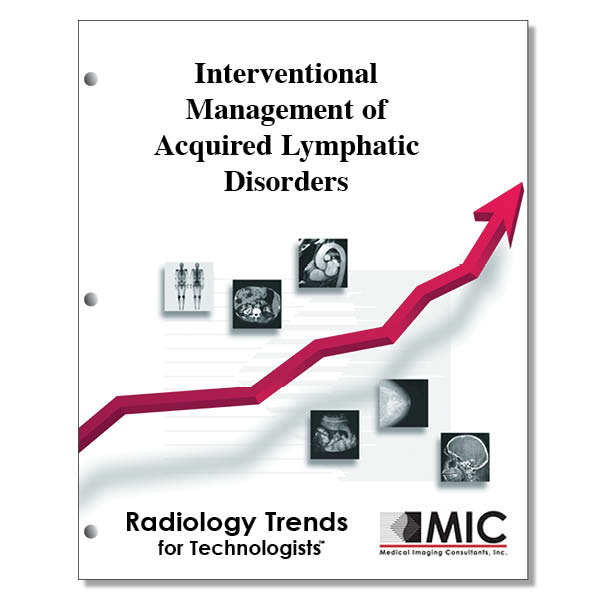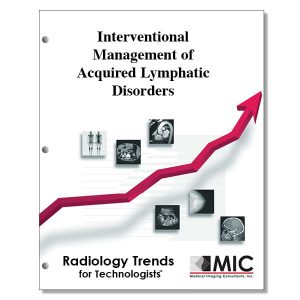

Interventional Management of Acquired Lymphatic Disorders
A review of lymphatic anatomy along with diagnostic and interventional techniques for treating patients with acquired lymphatic disorders.
Course ID: Q00784 Category: Radiology Trends for Technologists Modalities: CT, MRI, Radiography, RRA, Vascular Interventional2.25 |
Satisfaction Guarantee |
$24.00
- Targeted CE
- Outline
- Objectives
Targeted CE per ARRT’s Discipline, Category, and Subcategory classification:
[Note: Discipline-specific Targeted CE credits may be less than the total Category A credits approved for this course.]
Computed Tomography: 0.50
Procedures: 0.50
Neck and Chest: 0.25
Abdomen and Pelvis: 0.25
Magnetic Resonance Imaging: 0.50
Procedures: 0.50
Body: 0.50
Nuclear Medicine Technology: 0.25
Procedures: 0.25
Other Imaging Procedures: 0.25
Registered Radiologist Assistant: 2.25
Procedures: 2.25
Neurological, Vascular, and Lymphatic Sections: 2.25
Sonography: 0.25
Procedures: 0.25
Abdomen: 0.25
Radiation Therapy: 0.25
Procedures: 0.25
Treatment Sites and Tumors: 0.25
Vascular-Interventional Radiography: 2.25
Procedures: 2.25
Vascular Diagnostic Procedures: 2.25
Outline
- Introduction
- Conventional Anatomy
- Anatomic Variants of the TD
- Anatomic Variants: TD Insertion
- Chyle Leak
- Chylous Pleural Effusion
- Chylous Ascites
- Protein-Losing Enteropathy
- Lymphedema
- Chyle Leaks
- MR Lymphangiography
- Transpedal Lymphangiography
- Intranodal Lymphangiography
- Peripheral Lymphatic Embolization
- Transabdominal Access and TD Embolization
- Retrograde Transvenous and Transcervical Accesses
- Mesenteric Lymphangiography
- TD Stent Placement
- Transhepatic Lymphangiography and Embolization
Objectives
Upon completion of this course, students will:
- identify the most common causes of chyle leakage
- be familiar with the types of lymphatic disorders
- be familiar with the imaging procedures for diagnosis and management of lymphorrhea
- identify the main contributing compartments of the lymphatic system
- be familiar with the anatomy of the cisterna chyli
- be familiar with the physiology of the transthoracic duct
- be familiar with the lymph of the liver and intestinal compartments
- identify the anatomical variants of the TD
- identify the most common anatomical variant of the TD
- be familiar with the anatomic variant of the TD that leads to technical challenges
- be familiar with the physiologic causes of lymphatic flow disorders
- be familiar with the most common causes of chyle leaks
- be familiar with common sequelae of chyle leaks
- be familiar with the relationship of triglycerides and chylothorax
- describe the condition of chylous ascites
- identify the mechanisms for peritoneal accumulation of chyle
- be familiar with the normal physiology of total body albumin leaked into the gastric lumen
- identify the pharmacological agents that have shown benefits in the treatment of lymphatic flow disorders
- identify the advantages of using MRL for lymphatic imaging
- be familiar with the contrast media used for performing MRL
- be familiar with the number of lymphatic pathways in the lower extremity
- be familiar with the increased interest in performing intranodal lymphangiography
- identify the gauge of Chiba needle use for percutaneous access of the CC
- be familiar with the approaches to obtaining percutaneous retrograde access
- be familiar with the use of US to facilitate puncture of the mesenteric lymph nodes
- be familiar with the potential side effects of performing TD embolization
- be familiar with the successful treatments that TD stent offers
- be familiar with the connection between hepatic and duodenal lymphatics and PLE
- identify the liquid embolics injected
